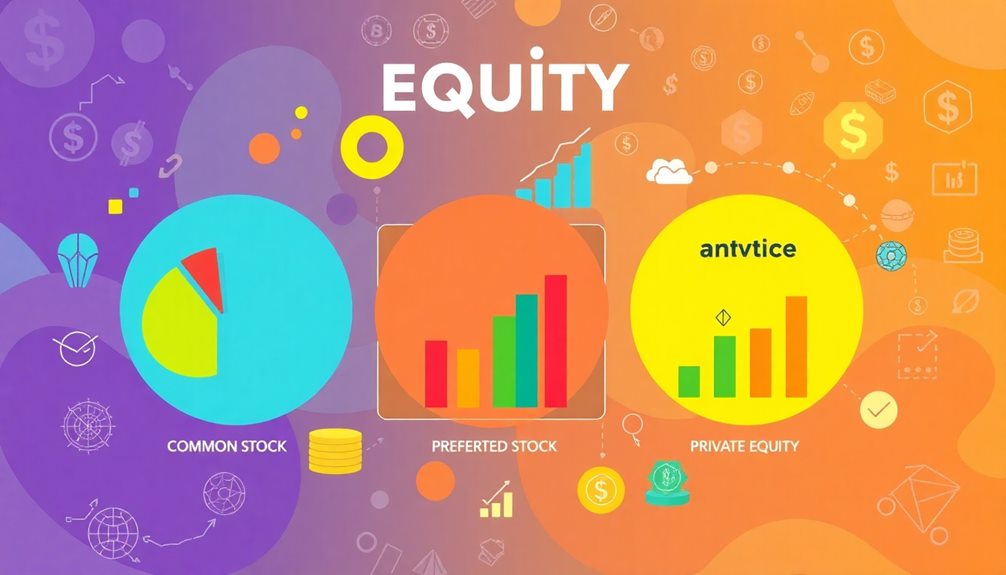Equity in finance refers to the ownership value of an asset after subtracting liabilities. You can think of it as the net worth available to shareholders, often expressed on a balance sheet through the formula: Total Assets minus Total Liabilities. Positive equity signals financial stability and attracts investors, while negative equity can indicate risk. In the stock market, equity represents ownership stakes in companies, which can fluctuate in value. Understanding equity isn't just about the numbers—it reveals the overall financial health of an entity. Explore further to uncover essential insights into equity and its impact on investments.
Key Takeaways
- Equity in finance represents ownership value in an asset, calculated as Total Assets minus Total Liabilities.
- Shareholder equity is crucial on a balance sheet, reflecting the net value available to shareholders.
- Private equity involves investments in non-public firms, often supported by institutional investors.
- Return on Equity (ROE) measures profitability using the formula: Net Income divided by Shareholder Equity.
- Stocks represent ownership shares in a company, while equity indicates the total ownership value after liabilities are accounted for.
Understanding Equity in Finance

When you plunge into the world of finance, understanding equity is vital. Equity represents the ownership value in an asset, calculated as total assets minus total liabilities. This figure shows the residual interest of shareholders after all obligations are met.
Shareholder equity is a key component of a company's balance sheet and includes elements like retained earnings, share capital, and treasury shares.
To assess a company's financial health, you'll want to look closely at shareholder equity. The formula for calculating it's straightforward: Shareholders Equity = Total Assets – Total Liabilities. Both total assets and liabilities are easily found on the balance sheet.
In the context of stocks, equity denotes ownership stakes represented by shares, which can fluctuate in market value based on company performance and economic conditions.
Return on equity (ROE) is another significant metric for investors; it evaluates a company's profitability by dividing net income by shareholder equity. A higher ROE indicates better financial performance, making it an important factor to reflect upon when analyzing a company's equity position.
Understanding these concepts will empower you to make informed investment decisions.
Types of Equity Explained

Now that you understand equity, let's explore the different types that exist.
You'll see how shareholder equity represents ownership in a company, while private equity focuses on investments in non-public firms.
Each type plays an essential role in the financial landscape, impacting both individual and institutional investors.
Shareholder Equity Overview
Shareholder equity is an essential measure of a company's financial health, representing the net value available to its shareholders. You can calculate it by subtracting total liabilities from total assets. This figure is pivotal for understanding a company's stability, as positive shareholder equity indicates that it has more assets than liabilities, which can attract potential investors.
Additionally, understanding shareholder equity can aid in developing an effective IRA Investment Strategy, especially for those looking to diversify their portfolios.
Shareholder equity comprises several components, including retained earnings, which reflect the company's profits reinvested in the business, and share capital, representing funds raised by issuing stocks. It can also include treasury shares, which are stocks repurchased by the company.
Market conditions can cause fluctuations in shareholder equity, affecting stock prices and investor sentiment. For instance, strong retained earnings growth can lead to increased equity, while poor performance can diminish it.
Companies often evaluate their return on equity (ROE) by dividing net income by shareholder equity, offering investors insight into profitability and efficiency.
Private Equity Insights
Private equity investments are frequently misunderstood, but they play an important role in the financial landscape. When you engage in private equity, you're participating in investments in non-publicly traded companies, often backed by substantial capital from institutional investors and accredited individuals.
Here are a few key aspects to reflect on:
- Types of Investments: This includes leveraged buyouts (LBOs) and venture capital.
- Valuation Method: It's calculated by evaluating total assets minus total liabilities.
- Focus on Returns: Investors seek higher returns, compensating for the risks involved.
Private equity firms typically enhance the value of their portfolio companies through operational improvements and strategic guidance. They analyze the company's valuation closely, ensuring that the assets are maximized while managing liabilities effectively.
By doing so, they aim for substantial returns upon exiting through sales or public offerings.
Understanding the dynamics of private equity allows you to appreciate the potential for significant investment growth, despite the inherent risks and illiquidity involved. It's a crucial component of a diverse investment strategy that can yield impressive rewards.
Calculating Shareholder Equity

When you calculate shareholder equity, you use the formula: Total Assets minus Total Liabilities.
This process hinges on analyzing a company's balance sheet, where you'll find essential figures like cash and debts.
Understanding this calculation is important; it not only reflects a company's financial health but also helps you make informed investment decisions.
Shareholder Equity Formula
Understanding the shareholder equity formula is essential for evaluating a company's financial health. This formula, expressed as Shareholders Equity = Total Assets – Total Liabilities, helps you determine the net worth available to shareholders after all debts are settled.
To grasp its significance, consider these key components:
- Total Assets: Everything the company owns, including cash, inventory, and fixed assets.
- Total Liabilities: All debts and obligations, like loans and accounts payable.
- Shareholder Equity: The remaining value after liabilities are subtracted from assets.
A positive shareholder equity indicates that a company enjoys financial stability, possessing more assets than liabilities. Conversely, negative equity can signal potential insolvency, raising red flags for investors.
Additionally, breaking down shareholder equity into share capital and retained earnings grants you a more detailed view of the company's financial position.
This metric is pivotal for investors, reflecting the company's ability to generate returns. It often appears in financial ratios like return on equity (ROE), helping you assess profitability.
Understanding how to calculate shareholder equity empowers you to make informed investment decisions.
Balance Sheet Analysis
Analyzing the balance sheet provides a thorough view of a company's financial position, particularly when calculating shareholder equity. You can determine shareholder equity using the formula: Shareholder Equity = Total Assets – Total Liabilities. This figure summarizes the company's net worth at a specific time.
Here's a quick breakdown of the key components:
| Component | Description | Importance |
|---|---|---|
| Total Assets | Resources owned (cash, inventory) | Indicates overall resources |
| Total Liabilities | Debts and obligations | Shows financial obligations |
| Shareholder Equity | Difference between assets and liabilities | Reflects financial stability |
When you analyze these elements through balance sheet analysis, you'll gain insights into retained earnings and share capital, which further enhance your understanding of the company's profitability and investment potential. A positive equity demonstrates that the company has enough assets to cover its liabilities, providing a cushion against financial distress. Conversely, negative equity can signal potential insolvency risks. Regularly monitoring shareholder equity helps you assess financial stability and make informed investment decisions.
Importance of Equity Calculation
Calculating shareholder equity is essential for evaluating a company's financial health and stability. This calculation helps you understand the net worth available to shareholders, which is derived from the formula: Shareholders Equity = Total Assets – Total Liabilities. By regularly reviewing this figure, you gain insights into the company's ability to meet its debt obligations and overall financial viability.
- Positive shareholder equity indicates more assets than liabilities.
- Understanding retained earnings and treasury shares can enhance your investment decisions.
- Significant fluctuations in equity can signal changes in profitability or capital structure.
When you monitor shareholder equity, you get a clearer picture of the company's financial stability. A positive shareholder equity not only reflects robust financial health but also attracts potential investors looking for reliable opportunities.
Additionally, knowing the components of shareholders equity, like retained earnings, allows you to evaluate the effectiveness of the company's reinvestment strategies. By staying informed about these aspects, you can make more informed investment decisions and better understand the company's long-term performance and growth potential.
The Relationship Between Stocks and Equity

Stocks and equity are closely intertwined concepts in the finance world, each playing a vital role in determining a company's financial health. Stocks represent individual shares of ownership in a company, while equity refers to the total value of ownership after all liabilities are deducted. You can calculate equity by subtracting total liabilities from total assets. Each share of stock corresponds to a claim on this equity, which means owning stocks is fundamentally owning a piece of that equity.
When a company sells stocks through an Initial Public Offering (IPO), it raises capital, increasing its equity base as the funds contribute to its total assets. The relationship is also seen in market capitalization, which you find by multiplying the share price by the total number of outstanding shares. This figure represents the total equity value recognized by the market.
Understanding the difference between stock prices and equity value is essential. Fluctuating stock prices can lead to variations in perceived equity value, impacting your investment decisions.
Importance of Return on Equity

Return on Equity (ROE) serves as an essential indicator for evaluating a company's profitability and efficiency in using shareholders' equity. By calculating ROE with the formula ROE = Net Income / Shareholders' Equity, you can measure how well a company generates profits from the equity invested by its shareholders.
Understanding the importance of ROE can help you make better investment decisions. Consider these key points:
- A higher ROE indicates greater efficiency in generating profits from each dollar of equity.
- Companies with an ROE above the industry average are often viewed as more attractive investments.
- Consistent increases in ROE can signal strong financial management and growth potential.
An ROE of 15% or higher is generally considered good, indicating that the company is delivering a solid return on the equity invested.
Investment Options and Resources

Investing in equity can take many forms, allowing you to tailor your strategy based on your financial goals and risk tolerance.
Equity investments like stocks, mutual funds, and ETFs provide diverse avenues for growing your wealth over time. In addition, understanding the legal aspects of financial decisions, such as divorce proceedings, can also impact your investment choices.
If you're a beginner, TD Easy Trade allows you to buy stocks and ETFs with no minimum investment, making it easy to start your investing journey.
For more seasoned investors, TD Direct Investing offers advanced tools and resources to analyze market trends and make informed decisions. You can use comparison tools to find the right DIY investing service that suits your needs by evaluating features, fees, and various investment options available.
Moreover, customer support services are invaluable, providing resources to answer common investment questions. This guarantees you have the assistance you need at every step of your investing journey.
Whether you're diving into stocks or exploring the benefits of mutual funds and ETFs, understanding your options will empower you to make smart choices. Embrace these resources and take control of your equity investments for a prosperous financial future.
Frequently Asked Questions
What Is Equity for Beginners?
Equity's about owning a piece of something valuable. It's what you get after subtracting debts from assets. Understanding equity helps you assess financial health, whether in investments, homes, or businesses you might be interested in.
What Is Equity Finance in Simple Terms?
Equity finance means raising money by selling ownership shares in your company. You attract investors who become part-owners, allowing you to fund growth or projects without worrying about repaying loans or paying interest.
Is Equity the Same as Profit?
Did you know that nearly 60% of small businesses fail due to cash flow issues? Equity isn't the same as profit; it represents ownership value, while profit indicates income after expenses. They're related but distinct.
What Is Equity Explained in Simple Terms?
Equity's simply the value you own in something after subtracting what you owe. It shows your financial stake, whether in a home or business, highlighting your potential for growth and stability in investments.
Conclusion
In finance, understanding equity is like holding the keys to a treasure chest; it reveals valuable insights into ownership and investment potential. By grasping the different types of equity and how to calculate shareholder equity, you can make informed decisions about your investments. Remember, a strong return on equity not only reflects a company's health but also signals opportunities for growth. So, immerse yourself in the world of equity, and let your financial knowledge guide you to success!










